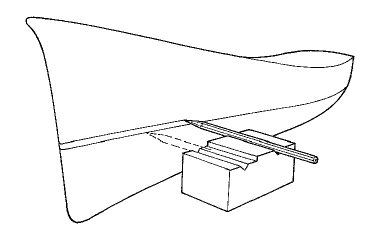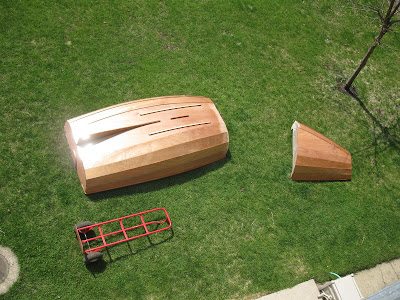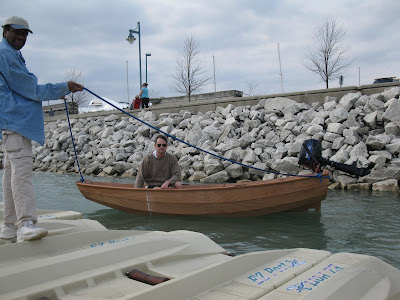
At this point, I had four coats of epoxy on the entire hull. It was time to finish off with the varnish and or paint depending on the area. I wanted to put the PMD in the water and find the dynamic water line. What I mean is that plans are nice, but how does this boat handle and where do I plan to have the paint start, and where should the bottom paint be. I was planning to keep the PMD in the water in the same spot as my 8' zodiac used to be. I planned to remove the bow, put it in the hull and have a cover made to keep the rain out. This first adventure helped alter my plans.
Birth of a PMD! First look at sunshine. Having fit through the door all the neighbors bet against, the PMD was on its way to some cold water on a sunny day in May. I hope you like the expense I went to for the car rack. I got two 2X4s and clamped them onto the cars luggage rack. I spent almost $15. See, I am becoming a sail boater already!!
The launch! Seems kind or un-ceremonious. No bottle of campaign or anything. This is a research project and not really a boating event. Will it float?
Yes it floats. You may notice what I wondered about. The PMD seems to be quite sensitive to the weight of the motor. This surprised me. It should not have. The PMD only weighs 90 pounds, the motor weighs 55 lbs. thanks to the new 4 stroke design.
This is a 6 hp motor, The 4, 5 and 6 hp all weigh the same but do not cost the same. It is interesting that they only change the timing and carb to get the different hp. I already had this motor. If I would choose one now, I would get a 3 or 4 hp used two stroke. Lighter and plenty of power.
I will now answer the questions you may have. How did the PMD handle with that large engine, Did you flip it over, Did you get arrested? did it break off the transom? Did the world end? No it was just fine. Ideally you need two people when motoring, even with a lighter engine. This will balance the boat. This boat handles better with a little weight in it!
If you are going to motor by yourself, you will need an extension on the motor handle so you can operate it from the middle seat or the floor. The boat is nicely balanced with my weight in the middle. In trials, I found the PMD will plane out under full power, if I sit forward and it is calm. It is not a planning hull nor is it a full displacement hull . It is a pram! I found a sweet spot of about one half throttle that uses very little gas and glides thru the water.
You can see the stern lifting when my weight is forward even with the engine.
The PMD is very light and has minimal displacement. The water line is on the fourth plank with no weight on board!
The first time I put the PMD in gear with the motor, I was amazed how fast it went at idle speed, My zodiac with the same engine at idle was much slower. Easier to push a slender shapely hull than a square shape!
I took a lot of pictures and now have a good idea of how I want to paint the PMD. Removing the bow is not a thing I think I will want to do every weekend. I may need a full length cover. Make sure and "drill fill drill" (drill oversize hole, fill entire hole with epoxy, then drill correct size hole through the epoxy.) the holes for the studs that hold on the bow, it is easy for the threads on the bolts to damage the plywood. Epoxy can take the punishment and it is not so easy to line up the bolts!
Time to go back to the shop and finish this boat!























